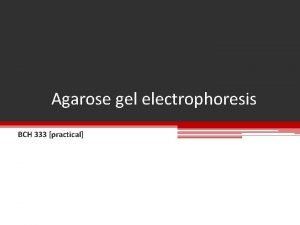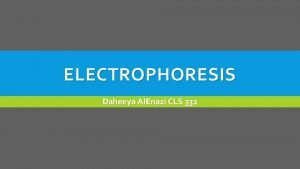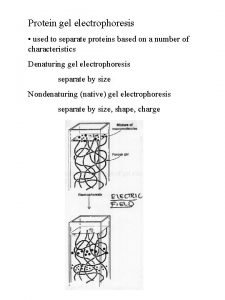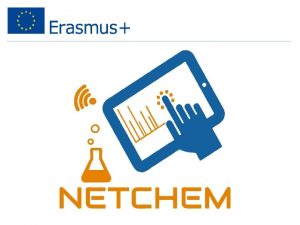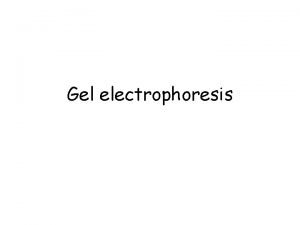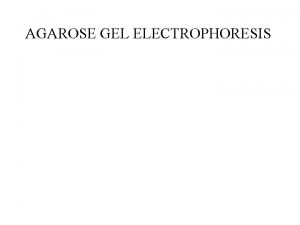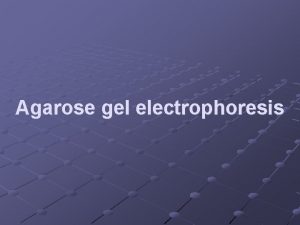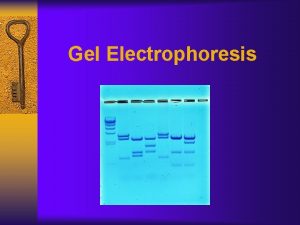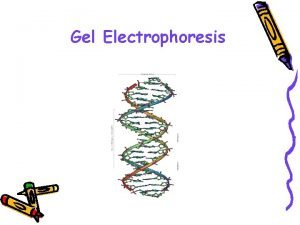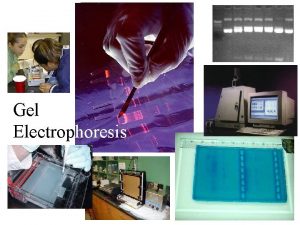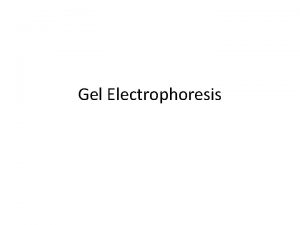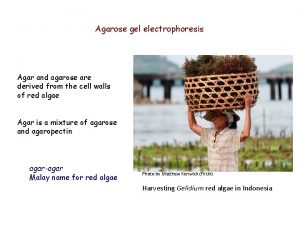SDSPolyacrylamide Gel Electrophoresis Agarose vs SDSPAGE Where agarose












- Slides: 12

SDS-Polyacrylamide Gel Electrophoresis Agarose vs. SDS-PAGE • Where agarose gels are best for running larger molecules, like DNA, SDS-PAGE is better suited for running smaller ones, like proteins.

SDS-PAGE has a number of uses • • • Establishing protein size Protein identification Determining sample purity Identifying disulfide bonds Quantifying proteins Blotting applications

SDS PAGE • SDS-PAGE stands for sodium dodecyl (lauryl) sulfatepolyacrylamide gel electrophoresis. The SDS portion is a detergent. • The purpose of the SDS detergent is to take the protein from its native shape, which is basically a big glob, and open it up into a linear piece.

Properties of SDS • SDS is an anionic detergent that binds quantitatively to proteins, giving them linearity and uniform charge, so that they can be separated solely on the basis if their size. • SDS has a high negative charge that imparts all proteins with a relatively equal negative charge. • SDS has a hydrophobic tail that interacts strongly with protein (polypeptide) chains. The number of SDS molecules that bind to a protein is proportional to the number of amino acids that make up the protein.

SDS • Each SDS molecule contributes two negative charges, overwhelming any charge the protein may have. • SDS also disrupts the forces that contribute to protein folding (tertiary structure), ensuring that the protein is not only uniformly negatively charged, but linear as well.

ELECTROPHORESIS • The polyacrylamide gel electrophoresis works in a similar fashion to an agarose gel, separating protein molecules according to their size. • In electrophoresis, an electric current is used to move the protein molecules across a polyacrylamide gel. The polyacrylamide gel is a cross-linked matrix that functions as a sieve to help "catch" the molecules as they are transported by the electric current.

PAGE • The PAGE acts somewhat like a threedimensional mesh or screen. The negatively charged protein molecules are pulled to the positive end by the current, but they encounter resistance from this polyacrylamide mesh. • The smaller molecules are able to navigate the mesh faster than the larger one, so they make it further down the gel than the larger molecules.

PAGE Staining • Once an SDS-PAGE gel is run, you need to fix the proteins in the gel so they don't come out when you stain the gel. Acetic acid 25% in water is a good fixative, as it keeps the proteins denatured. • The gel is typically stained with Coomasie blue dye R 250, and the fixative and dye can be prepared in the same solution using methanol as a solvent. The gel is then destained and dried.

Plotting the graph • Plot the relative mobility of each protein against the log of its molecular weight. • Relative mobility is the term used for the ratio of the distance the protein has moved from its point of origin (the beginning of the separating gel) relative to the distance the tracking dye has moved (the gel front). The ratio is abbreviated as Rf. Molecular weight is expressed in daltons.

Analyzing • A plot of the relative molecular weight of protein standards against the log of their molecular weight. • Relative mobility or (Rf) is calculated by measuring the distance of migration of a band within the gel divided by the length of the gel or distance of migration of the dye front. • The log of the molecular weight is extrapolated against the log (mol wt. ) for the known standards.

Western Blotting • The western blot (alternately, immunoblot) is a method to detect a specific protein in a given sample of tissue homogenate or extract. • It uses gel electrophoresis to separate native or denatured proteins by the length of the polypeptide (denaturing conditions) or by the 3 -D structure of the protein (native/ non-denaturing conditions). • The proteins are then transferred to a membrane (typically nitrocellulose or PVDF), where they are probed (detected) using antibodies specific to the target protein.

Western Blotting vs. Far-Western Blotting • Far-Western blotting was originally developed to screen protein expression libraries with 32 P-labeled glutathione Stransferase (GST)-fusion protein. • Far-Western blotting is now used to identify protein: protein interactions. In recent years, far-Western blotting has been used to determine receptor: ligand interactions and to screen libraries for interacting proteins. • With this method of analysis it is possible to study the effect of post-translational modifications on protein: protein interactions, examine interaction sequences using synthetic peptides as probes, 3 and identify protein: protein interactions without using antigen-specific antibodies. • Southern and Northern Blots
 Agarose vs acrylamide gel
Agarose vs acrylamide gel Pipetting exercises
Pipetting exercises Disadvantages of agarose gel electrophoresis
Disadvantages of agarose gel electrophoresis Gel electrophoresis advantages
Gel electrophoresis advantages Agarose gel vs polyacrylamide gel
Agarose gel vs polyacrylamide gel Gel electrophoresis principle
Gel electrophoresis principle Gel electrophoresis definition
Gel electrophoresis definition Translate image
Translate image Polyacrylamide gel electrophoresis (page)
Polyacrylamide gel electrophoresis (page) Basic principles of electrophoresis
Basic principles of electrophoresis Selective breeding definition biology
Selective breeding definition biology Is gel electrophoresis a biotechnology
Is gel electrophoresis a biotechnology Gel electrophoresis definition
Gel electrophoresis definition
